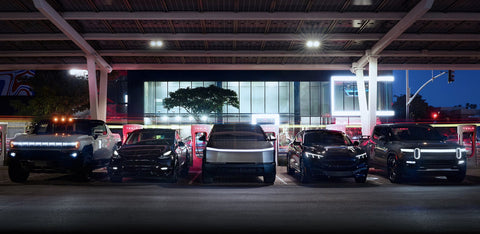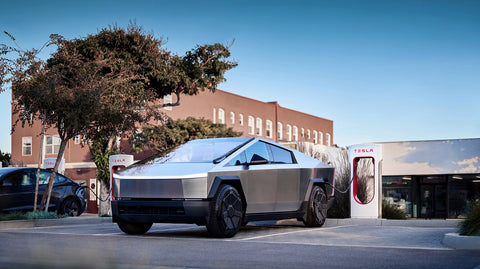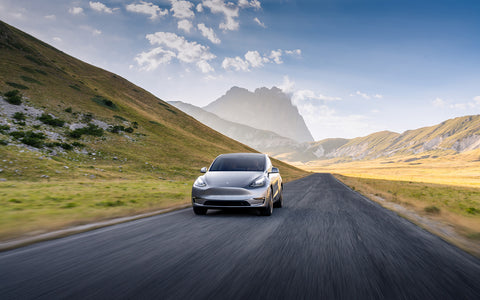In the realm of automotive innovation, one name stands out as a true disruptor: Tesla. Over the past decade, Tesla has spearheaded a transformative shift in the automotive market, redefining the possibilities of electric vehicles (EVs) and reshaping the way we perceive and interact with them. As the brainchild of visionary entrepreneur Elon Musk, Tesla has not only propelled the widespread adoption of EVs but has also revolutionized various aspects of the automotive industry.
At the heart of Tesla's success lies its unwavering commitment to pushing the boundaries of electric mobility. The company's groundbreaking journey began with the Tesla Roadster, an all-electric sports car that defied skeptics and demonstrated the potential of EVs. By showcasing impressive performance capabilities and extended range, the Roadster shattered preconceived notions about electric vehicles being sluggish and limited in distance.
Building upon the Roadster's success, Tesla proceeded to introduce a lineup of electric vehicles that appealed to a broader consumer base. The release of the Model S sedan, followed by the Model X SUV and the more affordable Model 3, marked a turning point in the perception of EVs as a viable alternative to traditional combustion engine vehicles. Tesla's vehicles not only offered impressive range and acceleration but also featured cutting-edge technologies, luxurious interiors, and a sleek aesthetic that challenged the notion of electric cars as mundane and unattractive.
One of the critical elements that propelled Tesla's success and accelerated the adoption of EVs is its Supercharging network. Tesla recognized early on that range anxiety, the fear of running out of battery power, was a significant barrier to widespread EV adoption. To address this concern, Tesla invested heavily in establishing a vast network of Supercharger stations strategically located around the world. These high-speed charging stations allow Tesla owners to quickly recharge their vehicles, reducing the anxiety associated with long-distance travel and making EV ownership more practical and convenient.
In addition to range anxiety, Tesla also tackled the concept of autonomous driving with its groundbreaking Autopilot technology. By equipping its vehicles with advanced sensors, cameras, and machine learning capabilities, Tesla has paved the way for self-driving cars. The introduction of Autopilot features, such as adaptive cruise control and lane-keeping assist, has not only improved safety but has also accelerated the development of autonomous vehicle technologies across the entire automotive industry.
Tesla's disruptive approach extends beyond its innovative technologies. The company has also challenged the traditional dealership model by adopting a direct-to-consumer sales approach. Instead of relying on third-party dealerships, Tesla sells its vehicles directly to customers through its showrooms and online platform. This direct sales model has empowered Tesla to maintain control over the customer experience, streamline the purchasing process, and foster a closer relationship with its customers.
As Tesla's influence continues to grow, it has ignited a domino effect within the automotive industry. Other automakers, once hesitant about EVs, have recognized the demand and potential for electric mobility. They are now investing heavily in EV development, charging infrastructure, and battery technology to keep pace with Tesla's advancements. The rise of Tesla has fueled a sense of urgency and competition within the industry, resulting in a wave of new electric vehicle models and a broader commitment to sustainability and decarbonization.
In conclusion, Tesla's impact on the automotive market has been nothing short of revolutionary. Through its groundbreaking electric vehicles, extensive charging infrastructure, autonomous driving technology, and disruptive sales model, Tesla has transformed the way we view and embrace electric mobility. As other automakers follow in its footsteps, the stage is set for a future where electric vehicles dominate the roads, paving the way towards a greener and more sustainable automotive landscape.

Section 1: Pioneering Electric Mobility
Tesla's journey to revolutionize the automotive market began with its pioneering approach to electric mobility. The company's visionary mindset challenged the prevailing perception of electric vehicles as impractical and limited in performance. Through a combination of cutting-edge technology, impressive range capabilities, and sleek design, Tesla demonstrated that electric cars could offer a thrilling driving experience while being environmentally friendly.
At the forefront of Tesla's electric vehicle lineup is the Tesla Roadster. Introduced in 2008, the Roadster shattered preconceived notions about EVs with its remarkable acceleration, reaching 0 to 60 mph in just 3.7 seconds. With a range of over 200 miles on a single charge, the Roadster showcased the potential of electric powertrains and dispelled concerns about limited driving distances. Its success laid the foundation for Tesla's subsequent models and ignited a global interest in electric mobility.
Building upon the Roadster's achievements, Tesla unveiled the Model S sedan, a luxury electric vehicle that combined style, performance, and sustainability. The Model S boasted an impressive driving range of up to 400 miles, making long-distance travel a realistic possibility for EV owners. Its sleek design and spacious interior further challenged the notion that electric vehicles had to compromise on aesthetics or comfort.
In 2015, Tesla expanded its lineup with the introduction of the Model X, an all-electric SUV that redefined family-oriented electric mobility. The Model X featured unique falcon-wing doors, providing unparalleled accessibility and versatility. With seating for up to seven passengers, ample cargo space, and dual electric motors for exceptional performance, the Model X showcased Tesla's commitment to pushing the boundaries of electric vehicle design and functionality.
However, Tesla's most significant milestone in the pursuit of electric mobility came with the release of the Model 3. Positioned as a more affordable option, the Model 3 aimed to bring electric vehicles to the mass market. With a starting price lower than its predecessors, the Model 3 achieved remarkable success, becoming one of the best-selling electric cars globally. Its range of up to 350 miles, advanced features, and minimalist interior design captivated consumers and accelerated the transition to electric mobility.
Beyond the performance and range capabilities, Tesla's electric vehicles are renowned for their innovative features. The vehicles are equipped with large touchscreen displays that provide seamless access to navigation, entertainment, and vehicle settings. Tesla also pioneered over-the-air software updates, allowing owners to receive new features and performance improvements wirelessly, further enhancing the ownership experience.
Tesla's relentless pursuit of electric mobility has not only transformed the perception of EVs but has also spurred other automakers to invest heavily in electric vehicle development. The company's commitment to pushing the boundaries of what electric vehicles can achieve has led to advancements in battery technology, charging infrastructure, and overall sustainability in the automotive industry.
As Tesla continues to refine and expand its electric vehicle lineup, the company remains at the forefront of the electric mobility revolution. With each new model and technological advancement, Tesla drives the industry towards a future where electric vehicles are the norm, paving the way for a greener and more sustainable transportation ecosystem.

Section 2: Supercharging Infrastructure
One of the key factors that has propelled Tesla's success and accelerated the adoption of electric vehicles is its revolutionary Supercharging infrastructure. Tesla recognized early on that to address range anxiety, an extensive and convenient charging network was crucial for widespread EV adoption. In response, the company embarked on a mission to establish a global network of Supercharger stations.
Tesla's Supercharger network is a comprehensive system of high-speed charging stations strategically placed along popular travel routes, enabling Tesla owners to embark on long-distance journeys with ease. These stations are typically located near highways, shopping centers, and other high-traffic areas, making it convenient for users to recharge their vehicles during road trips or daily commutes.
The Supercharger stations are designed to provide rapid charging, allowing Tesla vehicles to replenish their batteries quickly. With the introduction of the V3 Superchargers, Tesla has achieved remarkable charging speeds, delivering up to 250 kW of power. This means that Tesla vehicles can add hundreds of miles of range in a matter of minutes, significantly reducing the time required for charging compared to traditional charging solutions.
Tesla's Supercharger network is not only fast but also reliable. The company invests in redundant power supply and backup systems to ensure uninterrupted charging services. Additionally, Tesla actively monitors the Supercharger network and performs regular maintenance to ensure optimal functionality and customer satisfaction.
To enhance the charging experience, Tesla has developed user-friendly features within its vehicles and mobile app. Tesla owners can easily locate nearby Supercharger stations through the vehicle's navigation system or the Tesla mobile app. The app provides real-time information on station availability, estimated charging times, and even allows users to remotely monitor and control the charging process.
Furthermore, Tesla has implemented a pay-per-use model for Supercharging. While some earlier Tesla models came with free Supercharging for life, newer vehicles are charged a fee based on usage. This approach ensures that the Supercharger network remains sustainable and allows Tesla to continue expanding and maintaining the infrastructure.
Tesla's Supercharging network has not only alleviated range anxiety for its own customers but has also influenced the broader EV market. Other automakers and charging network providers have recognized the importance of a reliable and widespread charging infrastructure and have followed suit by investing in their own fast-charging networks. Tesla's success in establishing a robust charging network has set a benchmark for the industry, encouraging the growth and standardization of charging infrastructure worldwide.
In conclusion, Tesla's Supercharging infrastructure has played a vital role in driving the widespread adoption of electric vehicles. By providing a reliable, fast, and extensive charging network, Tesla has tackled range anxiety head-on and has made long-distance travel in electric vehicles a practical reality. The Supercharger network has not only benefited Tesla owners but has also influenced the entire automotive industry, spurring the development of charging networks and accelerating the transition to a sustainable transportation future.

Section 3: Autopilot and Autonomous Driving
One of the most groundbreaking aspects of Tesla's vehicles is their advanced Autopilot system, which represents a significant step towards autonomous driving. Tesla has been at the forefront of autonomous vehicle technology, integrating a range of sensors, cameras, and artificial intelligence capabilities to enable enhanced driver assistance features and pave the way for self-driving cars.
Tesla's Autopilot utilizes a combination of hardware and software to provide a semi-autonomous driving experience. The system includes a forward-facing radar, a suite of cameras, ultrasonic sensors, and a powerful onboard computer. These components work together to gather real-time data about the vehicle's surroundings, including other vehicles, pedestrians, and road infrastructure.
The Autopilot system offers a variety of advanced driver assistance features designed to enhance safety and convenience. These include adaptive cruise control, which maintains a safe distance from the vehicle ahead and adjusts the speed accordingly, and lane-keeping assist, which helps keep the vehicle within its designated lane. Autopilot can also automatically change lanes with driver confirmation and navigate on highways, including entering and exiting ramps.
Tesla's Autopilot system is continually evolving through over-the-air software updates. These updates introduce new features, performance improvements, and enhanced capabilities. Tesla leverages the vast amount of data collected from its fleet of vehicles to refine and train the Autopilot algorithms, making the system increasingly intelligent and responsive to real-world driving scenarios.
While Tesla's Autopilot system represents a significant advancement in autonomous driving technology, it is important to note that it is not a fully autonomous driving solution. Tesla drivers are still required to remain attentive and engaged while using Autopilot and must be prepared to take control of the vehicle when necessary. Tesla emphasizes the importance of hands-on driving and encourages drivers to keep their hands on the steering wheel at all times.
Tesla's commitment to autonomous driving extends beyond its Autopilot system. The company is actively developing and testing its own fully autonomous driving software, known as "Full Self-Driving" (FSD). FSD aims to enable Tesla vehicles to navigate and operate without human intervention in a wide range of driving scenarios, including urban environments and complex intersections. While FSD remains under development and is subject to regulatory approval, Tesla has been gradually rolling out beta versions of the software to a limited number of customers for testing and feedback.
Tesla's advancements in autonomous driving technology have had a profound impact on the automotive industry as a whole. The company's relentless pursuit of self-driving capabilities has encouraged other automakers to invest heavily in autonomous vehicle research and development. As a result, the industry has witnessed significant progress in the development of advanced driver assistance systems and the race towards fully autonomous vehicles.
In conclusion, Tesla's Autopilot system represents a significant milestone in the journey towards autonomous driving. With its advanced sensor suite, powerful onboard computer, and over-the-air software updates, Tesla continues to push the boundaries of what is possible in terms of driver assistance features. While full autonomy is still a work in progress, Tesla's efforts have set the stage for a future where self-driving cars become a reality, transforming the way we travel and shaping the future of the automotive industry.

Section 4: Direct-to-Consumer Sales Model
Tesla has revolutionized the automotive industry not only with its electric vehicles but also with its unique and disruptive direct-to-consumer sales model. Breaking away from the traditional dealership model, Tesla has adopted a direct sales approach, allowing the company to have direct control over the entire customer experience from start to finish.
One of the key advantages of Tesla's direct-to-consumer sales model is the elimination of third-party dealerships. Tesla operates its own retail stores and galleries, strategically located in high-traffic areas such as shopping centers and urban hubs. These stores provide a unique and interactive experience for customers, allowing them to explore Tesla vehicles, learn about the technology, and even schedule test drives.
By bypassing dealerships, Tesla maintains complete control over the sales process. Customers can place orders for Tesla vehicles directly through the company's website or by visiting a Tesla store. This streamlined approach reduces the complexity and potential markups associated with traditional dealership networks, resulting in a more transparent and efficient purchasing process.
Another advantage of Tesla's direct sales model is the ability to maintain a closer relationship with customers. Tesla's sales staff is trained extensively to be knowledgeable about the vehicles, charging infrastructure, and software features. This allows them to provide personalized and in-depth information to customers, helping them make informed decisions based on their specific needs and preferences.
Furthermore, Tesla's direct sales model enables the company to gather valuable customer feedback and insights. As Tesla owns the entire sales process, it has a direct line of communication with customers, allowing them to gather feedback on vehicle performance, features, and overall satisfaction. This feedback loop helps Tesla continuously improve its products and services, ensuring that customer needs are met and exceeded.
Tesla's direct sales model also extends to the after-sales experience. The company operates its own service centers, known as Tesla Service Centers, where customers can schedule maintenance and repairs for their vehicles. These service centers are staffed with Tesla-trained technicians who have specialized knowledge of the vehicles and can provide efficient and high-quality service.
In addition to physical service centers, Tesla has developed a remote diagnostics and over-the-air software update capability, allowing many issues to be resolved remotely without the need for a service center visit. This approach minimizes inconvenience for customers and ensures that vehicles are kept up to date with the latest software features and improvements.
Tesla's direct-to-consumer sales model has faced challenges in some regions due to existing dealership franchise laws. These laws, designed to protect traditional dealership networks, often restrict or prohibit direct sales by manufacturers. However, Tesla has navigated these regulatory hurdles by employing creative solutions, such as operating galleries where customers can learn about the vehicles but not make purchases, and then completing the sales process online.
In conclusion, Tesla's direct-to-consumer sales model has disrupted the traditional dealership model and has given the company greater control over the customer experience. By operating its own retail stores, sales process, and service centers, Tesla has been able to provide a more transparent and personalized experience for customers. This approach has allowed Tesla to build strong customer relationships, gather valuable feedback, and continuously improve its products and services.

Conclusion:
Tesla's impact on the automotive market cannot be understated. Through groundbreaking electric vehicles, an extensive charging infrastructure, autonomous driving technology, and a disruptive sales model, Tesla has revolutionized the industry. As other automakers follow suit, the automotive landscape is rapidly shifting towards a future where electric mobility is the norm.
Tesla's introduction of electric vehicles with exceptional range, performance, and design has shattered preconceived notions about electric cars and demonstrated that sustainable transportation can be both practical and desirable. The company's relentless focus on battery technology advancements and the establishment of its Gigafactories have driven down costs, making electric vehicles more accessible to a broader range of consumers.
Furthermore, Tesla's Supercharger network has addressed one of the main barriers to electric vehicle adoption by providing convenient and fast charging options along major travel routes. This infrastructure has alleviated concerns about range anxiety and paved the way for long-distance electric travel.
Tesla's commitment to autonomous driving technology has also pushed the boundaries of what is possible in the automotive industry. While full autonomy is still a work in progress, Tesla's Autopilot features have brought advanced driver-assistance systems to the mainstream, enhancing safety and convenience for Tesla owners.
In addition, Tesla's direct-to-consumer sales model has disrupted the traditional dealership model, giving the company greater control over the customer experience and fostering stronger relationships with its customers. By providing a transparent, personalized, and efficient sales process, Tesla has set a new standard for automotive retail.
As other automakers witness Tesla's success, they are embracing electric vehicle technology and investing heavily in their own electric vehicle offerings. This increased competition is driving further innovation and improvement in electric vehicle performance, range, and affordability. The industry is experiencing a rapid transition towards a future where electric mobility is not only environmentally friendly but also economically viable and technologically advanced.
Tesla's impact extends beyond the automotive market. The company's commitment to sustainability, demonstrated through its energy storage solutions, solar technology, and responsible supply chain practices, has influenced the broader energy sector and inspired a mindset shift towards renewable energy sources and efficient energy management.
In conclusion, Tesla's transformative influence on the automotive market and the broader industry cannot be overstated. Through its innovative electric vehicles, charging infrastructure, autonomous driving technology, and disruptive approach to sales, Tesla has accelerated the transition to a sustainable future. As the industry continues to evolve, electric mobility will become increasingly prevalent, contributing to a cleaner, greener, and more efficient transportation ecosystem.

